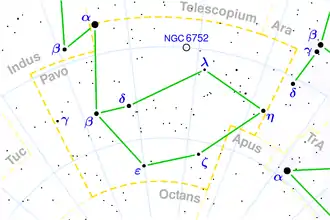NGC 6502
NGC 6502 ist eine 12,6 mag helle linsenförmige Galaxie vom Hubble-Typ E/S0[2] im Sternbild Pfau am Südsternhimmel. Sie ist schätzungsweise 241 Millionen Lichtjahre von der Milchstraße entfernt und hat einen Durchmesser von etwa 95.000 Lichtjahren.
| Galaxie NGC 6502 | |
|---|---|
| AladinLite | |
| Sternbild | Pfau |
| Position Äquinoktium: J2000.0, Epoche: J2000.0 | |
| Rektaszension | 18h 04m 13,72s[1] |
| Deklination | -65° 24′ 35,8″[1] |
| Erscheinungsbild | |
| Morphologischer Typ | SA0-:[1] |
| Helligkeit (visuell) | 12,5 mag[2] |
| Helligkeit (B-Band) | 13,5 mag[2] |
| Winkelausdehnung | 1,3′ × 1,1′[2] |
| Positionswinkel | 42°[2] |
| Flächenhelligkeit | 12,7 mag/arcmin²[2] |
| Physikalische Daten | |
| Rotverschiebung | 0,018393 ± 0,000057[1] |
| Radialgeschwindigkeit | (5514 ± 17) km/s[1] |
| Hubbledistanz vrad / H0 |
(241 ± 17) · 106 Lj (74,0 ± 5,2) Mpc [1] |
| Geschichte | |
| Entdeckung | John Herschel |
| Entdeckungsdatum | 20. Juli 1835 |
| Katalogbezeichnungen | |
| NGC 6502 • PGC 61352 • ESO 103-002 • 2MASX J18041368-6524357 • SGC 175913-6524.7 • GC 4350 • h 3716 • 2MASS J18041372-6524358 • WISEA J180413.77-652435.7 | |
Das Objekt wurde am 20. Juni 1835 von John Herschel[3] mit einem 18-Zoll-Spiegelteleskop entdeckt, der bei zwei Beobachtungen „vF, 30 arcseconds, involves 2 or 3 stars“ und „the following star (14m) of a vF double star 11m is nebulous. The nebula is excessively faint, but I am sure of its existence. The preceding star is free“[4] notierte.
Weblinks
Einzelnachweise
- NASA/IPAC EXTRAGALACTIC DATABASE
- SEDS: NGC 6502
- Seligman
- Auke Slotegraaf: NGC 6502. Deep Sky Observer's Companion, abgerufen am 7. August 2016 (englisch).
This article is issued from Wikipedia. The text is licensed under Creative Commons - Attribution - Sharealike. The authors of the article are listed here. Additional terms may apply for the media files, click on images to show image meta data.
